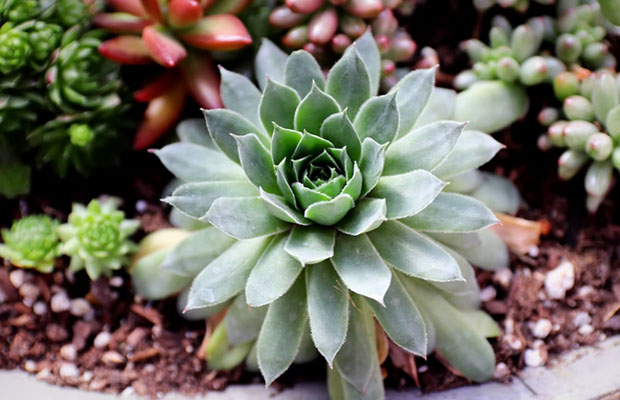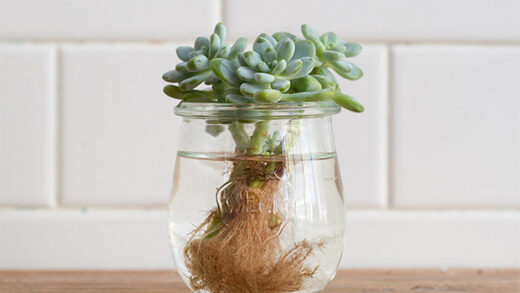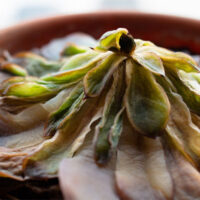Succulents can be used to create a striking container arrangement, a colorful rock garden, or even a piece of outdoor wall art. They are many popular succulents types you can choose from, which is an exotic and eye-catching way to enhance your garden. In addition to being hardy and resilient, succulents prefer neglect to ongoing care.
This post will help you get off to a good start if you’ve never grown succulents before and want to learn how to plant succulents.
If you’ve attempted to grow succulents in the past but unintentionally killed them, I believe this post will help you identify your mistakes. So let’s get started!
Read More: Fertilizer For Succulents
Table of Contents
What Are Succulents?
Worldwide, succulent plants are grown. Additionally, they have fleshy leaves, stems, or roots, as well as fascinating shapes, textures, and colors. A few well-known examples are sedum, agave, and echeveria. (Although not all succulents are cacti, cacti are succulents.) These simple plants are simple to grow. They are great, low-maintenance options for your containers because they are excellent water savers.
How To Plant Succulents?
Step 1: Use Potting Mix
Fill your preferred bowl with the potting mix before planting or repotting succulents. Use a specific soil blend made for succulents or make your own by adding sand to potting soil to increase its porosity. (Always keep in mind that succulents dislike wet roots.)
Step 2: Set The Plants In A Bowl
Turn the plant upside down in your hand, then pull off the nursery pot to free it from the container. Then place the plant in the bowl or other container’s center. Wearing gloves is advised because some succulents, like agave, have sharp edges. Start with one plant to make a succulent arrangement; typically the biggest or most eye-catching.
Step 3: Arrange The Plants
After that, plant near the bowl’s or succulent planter’s edges. Various succulents can be used to add texture and color. Planting them too closely won’t harm them because they can stand it. You want them to appear dense and lush.
Step 4: Finish The Arrangement
By lightly tamping the soil mixture, fill in any gaps. Gravel, aquarium stones, or another decorative material can be used as a finishing touch.
Step 5: Water The Bowl
To direct the stream of water into the soil rather than on the foliage, use a watering can with a narrow spout. Please be mindful not to overwater succulents as their root systems are excellent at supplying moisture to the plants.

How To Care Succulents?
Succulent pots still need some things, even though they don’t need as much watering and care as other plant types.
- Bowl: Use a container with a drainage hole at the bottom, please. Drill a number of tiny holes if the container is missing one.
- Potting Mix: Because succulents don’t like their roots to be wet, your soil should drain easily (which is why you need the drainage hole in the bottom of the container).
- Light: Put succulents in a location with direct sunlight because they love the sun. How Much Light Do Succulents Need? Your plants should get six to eight hours of direct sunlight each day. However, many succulents thrive indoors in direct, bright light. For information on light requirements, check the plant tag.
- Water: Although all plants require water to survive, succulents don’t require much. They are also very low maintenance as a result. Squeeze a succulent leaf gently to determine when to water it. The leaf doesn’t need to be watered if it is firm; however, if there is any squish, watering is required. Read More: How Much Water Do Succulents Need?
- Temperature: Some succulents, like sedum, are hardy. In the winter, other people require protection. Indoors before the first frost.
- Gravel: Although optional, gravel or another decorative topcoat gives the arrangement a finished appearance and prevents soil from splashing onto the foliage when watering.
Related Reading: How to Care for Outdoor Succulents?
How To Water Succulents After Planting?
Don’t water your succulents right away after repotting them, despite what you might think. You should give them their first drink of water after about a week, in my opinion.
If you water them after planting, any roots that were damaged by the transplant or were already damaged can end up rotting or diseased. It will take a few days for those roots to callus over or heal, preventing them from absorbing water that would cause them to rot.
Furthermore, since succulents tolerate dry soil, they won’t mind the wait.
You can use a small watering can to water one or two succulents in a pot that you recently potted. If, however, you planted them the way I did in the photo above, you’ll be better off using a watering squeeze bottle because it will let you be more precise with your water application.
Related Reading: How Often & How to Water Succulents?
Tips For Growing Succulents
1. Protect Succulents From Extreme Temperatures
Only a few varieties of succulents can survive temperatures below freezing, so keep that in mind if you intend to grow them outdoors. And while most succulents enjoy the heat and sun, some desert environments can be too harsh. There are exceptions, Alpine species such as sedums and sempervivums can withstand temperatures below zero. Additionally, most cacti, aloes, and succulents like agaves can survive in the high desert heat.
2. Don’t Backfill After Planting
Dig a hole in the size of the succulent’s root ball for planting succulents in the garden. “so leave the plant now! Don’t backfill or tuck the soil back in around the roots,” Jesch stresses.
Leaving this space open enables the soil to gradually re-infiltrate around the roots at the same rate as the plant. This encourages the development of new roots close to the soil surface, where they have access to air. (View Jesch’s demonstration of how to plant succulents outdoors properly in this video.)
Because it can retain too much moisture, most succulents don’t like a lot of organic material blended or tilled into the soil close to their roots. “Applying mulch should not be done close to the succulents’ crown or base. Taper down or pull away a bit so it’s not sitting on or collaring the plant up close and deep,” Apply a nonorganic mulch, like crushed rock, granite, or decorative stone, advises Jesch. These mulches will keep the soil cool and stop erosion while allowing the soil to dry out.
3. Don’t Give Them Too Much Sun
Many inexperienced succulent growers believe that the sunniest spot in the garden is the best place for their plants, but not all succulents enjoy spending the entire day in the sunbathing position. “Among the thousands of different succulent varieties, preferences are incredibly diverse. Some people prefer shade, while others prefer filtered light, sun, and strong sun. As a generalization, most like at least two to three hours of sun or filtered sun a day,” says Jesch.
Place succulents by a window or in a garden room where they will receive at least two or three hours of full sun each day if you’re growing them indoors. You can overwinter your succulents under grow lights if there isn’t a window with direct sunlight. Bring your plants outside gradually to give them time to acclimate so they won’t get sunburned when they can once more enjoy the outdoors.
4. Give Them The Right Mix Of Soil And Sand
It’s crucial to add sand or pumice to your soil mix to improve drainage because succulents don’t like having their roots sit in wet soil. Perlite, small gravel, crushed granite, or Turface (a calcined clay product) are additional non-organic substances that can be used to help loosen the soil.
“To prevent the soil from becoming too heavy, we prefer to use volcanic sands (pumice and scoria), but ordinary sand is also acceptable. Because of issues with shipping weight, most commercial mixes don’t have enough sand. About 60% nonorganic and 40% organic material is what provides good drainage and permanence,” says Jesch.
5. Put Them In Pots
If you can’t grow succulents outdoors all year round, the best option is to plant them in pots or other containers so you can move them easily indoors or to a protected area when the weather changes. Succulents that will thrive on a sunny windowsill include Haworthia, Gasteria, crown of thorns (Euphorbia millii), Easter lily cactus (Echinopsis), Sanseveria, and Christmas cactus (Zygocactus).
“When planting in pots, it’s not so critical to leave that air gap, as long as the pot drains well and you don’t plant them too deeply,” says The use of a quick-draining soil mix is crucial, just like with in-ground planting, Jesch. A regular potting soil mix can benefit from adding some coarse sand or gravel to improve drainage.
Jesch suggests waiting two to three days after potting succulents before giving them a good watering. This will give the roots some time to recover before soaking up water and avert root rot. It’s also important to have enough drainage holes in the container to allow the water to drain through, wash out salts, and exchange oxygen.
6. Succulents (Even Cacti) Like Water
Contrary to popular belief, giving your succulents regular water during the active growing season won’t kill them. In order to allow the roots to breathe, it’s important to wait until the soil is completely dry between waterings. “This can occur as frequently as every few days to as infrequently as every two to three weeks during cool or low-light seasons, depending on the weather, time of year, the size of the pot, and the soil conditions in the garden. I’ve seen many succulents go for several months without water and still survive,” says Jesch.
How can you tell if your succulent plants are receiving the right amount of water, then? The best gauge is how healthy their leaves are. The leaves of your succulents will appear shriveled, dull, and without shine, if they are thirsty. Overwatering is indicated by mushy or yellowing leaves and stem or root rot.
7. Don’t Be Afraid To Prune
Never be afraid to trim or shape succulents if they start to grow out of control, especially if there are several plants nearby. This will prevent one variety from overpowering another.
“Tipping, clipping, removing branches, and dividing are all acceptable techniques. After pruning, you can replant the cuttings or give them to friends,” says Jesch. To prevent them from absorbing too much water, let the cuttings heal and dry out at the wound for a few days prior to planting.
Additionally, regularly remove any dry or dead leaves from the plant’s base and surrounding areas. As they develop and mature, succulents naturally lose their lower and outer leaves. Not only will removing the shriveled foliage make your plants look better, but it will also encourage new growth and improve airflow.
8. Keep Them Well-fed
Because they don’t have deep, extensive root systems to look for nutrient sources, all succulents and cacti require regular fertilization. “Without adequate fertilizer, succulents will yellow, stop growing, and lose their beautiful luster and foliage colors that we love them for,” says Jesch.
After placing succulents in the garden, he advises applying an all-purpose 15-15-15 fertilizer within a few weeks and then repeating the process twice or three times a year. Apply a general-purpose houseplant fertilizer once a month to potted succulent plants.
Related Reading: Why is My Succulent Dying?
When To Repot Succulents
You may need to repot succulents on occasion. The initial is immediately following purchase. Succulents are frequently grown in nurseries in very organic soil that has poor drainage.
This works reasonably well in the greenhouse where the climate is controlled, but it typically doesn’t work well once you bring your succulents home. After buying succulents, it’s best to repot them in new soil.
Your succulents may also need to be replanted if the pot they are in is full or too small for them. Often they’ll be “root bound” meaning the roots are filling up the pot and the plant doesn’t have space to grow more roots.
Being root bound can help slow down the rate of growth for succulents, which saves the nursery money by reducing the frequency with which they need to be repotted.
As a general rule, I recommend leaving about 1/2″ to 1″ (1-2.5cm) between the edge of the pot and your succulent’s leaves. If your succulent is about 3″ (7.5cm) in diameter, then you’ll want to place it in a pot that’s about 4″ (10cm) in diameter.
5 Ideas For Using Succulents In The Garden
- Planting succulents closely together in accordance with a design template will result in a succulent tapestry. Utilize plants of various hues and shapes as your embroidery threads, and weave them together to create a living artwork.
- By planting a collection of succulents that resemble underwater plants or creatures, you can recreate the exotic world of life beneath the sea. For ideas, see these “seascape” plant selections from Waterwise Botanicals.
- Grow succulents in cracks in natural stone or stone-look containers as an alternative to a traditional rock garden so they appear to be emerging from a rocky outcropping.
- A high-impact way to display a variety of succulent colors, shapes, contrasts, and textures is with living walls and vertical gardens made of succulents. See how a tiny backyard in Northern California was transformed into a living succulent wall.
- Plant succulents in old pallets or fence wood letter frame to create a succulent letter garden. You can spell out whole words and phrases, your first or last name, or both. Just keep in mind that curved letters will be more challenging to create than straight-sided letters.
Final Words
These are the fundamentals of planting succulents. Keep in mind that if you don’t like where you placed your succulents when you first planted them, you can always move them around.
Although you should be gentle when handling your plants, you should also be aware that these tough creatures can withstand one or two moves without any issues. Wish you happy planting and good luck!
Read More: How to Replant Succulents?

















